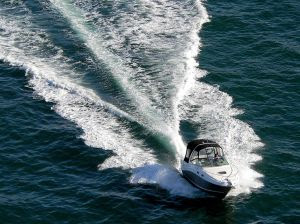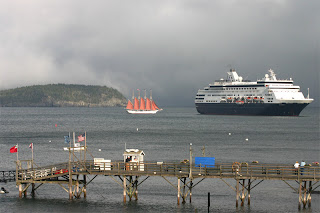With a week left before the IQP experience comes to an end, things are starting to wrap up.
Sunday, December 13, 2009
Project Update
With a week left before the IQP experience comes to an end, things are starting to wrap up.
Friday, December 11, 2009
Visualizing The Impacts
Here is the first video of many using our original time lapse and real time film to visualize the impact of the cruise ship industry on the city of Venice.
Thursday, December 10, 2009
Hydrodynamic Effects of Cruise Ships
When smaller ships reach a certain speed while traveling through the water, they will normally create a wake. A wake, by definition, is “The V shaped water that trails behind a boat, created by the boat's forward motion.” These wakes can beat against rock and dirt on the shore, causing them to erode.

Cruise ships only make these types of wakes at high speeds; at low speeds they will create a type of suction that is caused when the water in front of the boat is forced underneath the breaker by the movement and sheer displacement of the ship. The water pulled under the ship is then sent out under the back end of the ship in a sort of trailing wave that extends like a “V.”. This double whammy of effects caused by cruise ships passing is erosive, whether it’s the suction of water away from surrounding dirt and stone, or the wave after the passing of the boat that beats against said dirt and stone.
Cruise ships displace a lot of water. These gargantuan boats are essentially floating cities, having swimming pools to shopping centers to basketball courts to full sized gyms and 5 star dining. The way displacement works is that a large ship would displace the amount of water that essentially would fill it. The amount of the liquid that would fill the ship is referred to in units of tonnes. Wikipedia defines tonnes as follows:
“The spelling tonne has its origin in French. The term applied to the barrel of the largest size. In Old English the spelling was tunne, "cask" — a full cask about a meter high could easily weigh a tonne. The antiquated British wine cask volume measurement tun is close to a metric tonne in weight as it defines about 954 liters which for many commonly used liquids (aqueous solutions) approximates to as many kilograms.”
As previously stated, modern day cruise ships are quite large and thus displace large volumes of water. The largest cruise ship to have ever visited the city of Venice displaced an amazing 110,000 tonnes. Even more astounding is the displacement of the largest and most recent cruise ship: the M.S. Oasis has a displacement of a whopping 220,000 tonnes!
In Venice, cruise ships have to travel through the Giudecca Canal to reach the harbor. Since there is a chance of having one of these enormous cruise ships misjudging a turn or causing a catastrophic accident while traveling through the Giudecca on its own, all cruise ships that wish to dock at Venice’s port must be brought into port with the assistance of a tug boat. Some of the larger cruise ships actually require the use of two tug boats to help the ship navigate around the two bends in the Giudecca Canal.
Now picture Venice, where the main motorized means of transportation is by boat - there are a lot of wakes. Cruise ships are very heavy and displace so much water that having them dragged through the Giudecca canal at 5 knots (the speed at which they are allowed), causes a great amount of suction towards the ship and plenty of surrounding canals to pull water from. With all of this water being pulled in, the wave after the ship passes will be larger, causing even more erosion.
There is only one way in and one way out of Venice for these ships, so each would cause the erosion just described twice during their stay in Venice. With the city itself having been visited by over 500 cruise ships in 2008, it was dealt double that amount of erosive passes by the giant ships. With so much erosion caused by cruise ships alone, you forget to add to that all the erosion caused by regular boat travel and the fast ferries that visit Venice every day!
Saturday, November 7, 2009
Tuesday, October 20, 2009
Final Proposal
Thank you everybody for your help and keep visiting the blog to keep up to date on our project and how our time in Venice is going.
Tuesday, October 13, 2009
Keeping an Eye on Tourism the World Around
The state of travel and tourism in the world has been monitored by the World Tourism and Travel Council (WTTC) since 1990. Currently, WTTC is headed by President and CEO Jean-Claude Baumgarten, a French businessman who spent almost 30 years in management with air France, eventually climbing to become the Advisor to the Chairman. He, along with an executive team of similar backgrounds and over 100 members, seek to profile the status of travel and tourism, as well as its impact on the worlds economy. Publications profiling 176 countries are released annually, and plans to study and report on individual cities are underway. The largest publication, however, is Progress and Priorities, the yearly report on achievements and progress toward their ultimate goals. It also contains the financial information regarding travel and tourism in the world economy, revealing just how much the industry has been growing, and the numbers are astonishing.
Progress and Priorities 2007/08 states that in 2007, the direct and indirect elements of travel and tourism were expected to account for 10.4% of the world GDP, roughly $5.39 trillion. Over 231 million jobs were expected to be a result of travel and tourism, representing over 8% of the worlds total employment. These numbers increased in the next year, when WTTC released Progress and Priorities 2008/09. It estimated that in 2008, the direct and indirect impact of travel and tourism would total to $5.89 trillion, and would contribute 238 million jobs to the world’s employment. To put this in perspective, $5.89, and even $5.39 trillion, is larger than the national GDP of every country in the world except for the United States. These numbers are expected to only go up. WTTC predicts that by 2019, the contribution to the world GDP will be $10.48 trillion, more than double Japan’s current GDP.
The WTTC not only monitors the economics of travel and tourism, but also the tourist numbers and modes of transportation. According to their statistics, cruise shipping has seen an increase akin to that of the entire industry. In the ten-year span between 1998 and 2008, international tourist numbers climbed 36% from 1,291,120,000 to 1,756,310,000, and cruise ship passengers rose from 17,069,100 to 33,358,300, an increase of over 95%. In the same ten-year period, world tourists increased by one third, but cruise tourists almost doubled, illustrating the resurgence that the industry has experienced in recent years.
Tuesday, October 6, 2009
Close to Home Comparison

With the ever expanding cruise ship industry growing at an astonishing rate all across the world, it is not surprising that Venice is not the only community being affected by these floating cities. In fact, Bar Harbor, Maine, a rustic town in "Downeast" Maine, is a very comparable example. Located roughly halfway up the Maine coast, this small town of 4,800 has seen the number of cruise visits rise over three hundred and fifty percent since 2002. With 96 cruise ships bound for its docks (6 of which are bringing 2200+ passengers), Bar Harbor is certainly no stranger to big ships. However, the same as with Venice, the question still burning is whether or not these ships help or hurt the places they anchor.
With thousands of tourists eager to stretch their legs and open their wallets, the economic force of these large ships cannot be ignored. A study done by University of Maine students in 2005 showed that the average passenger off of a cruise ship spent $105.82 USD in Bar Harbor. By taking the number of passengers that also visited that year (nearly 130,000), this works out to 10 million USD. Tourist spending, however, is not the only source of income that these ships bring into the area. Charging fees at docking also brings in another estimated 2.5 million. These fees included $1,750 for anchorage, $4 per passenger, $150 per tour bus, and $40 per hour for a police detail. With all of these sources combined, cruise ships and their passengers net Bar Harbor ten percent of its yearly income.
Success, however, rarely ever comes without a price. The massive influx of passengers arriving by sea has also produced more than its fair share of problems. In 2005, Bar Harbor police reported 376 arrests involving cruise ship passengers, 91 of which were alcohol related. These numbers began to throw up red flags in the small 4,800 person community. Ensuing studies discovered just how much the spike in tourism was affecting crime. Cruise ship passengers testified to cruise-dedicated pimps and prostitutes ready to service male passengers fresh off the ship, a crime almost unheard of in the entire state, let alone in the rustic coastal town. 
Crime, however, is not the only recognized problem faced by locals. Congestion in the city streets cause by surges of passengers has also been a key problem. As you might imagine, a town of 4,800 people is not entirely equipped to support foot traffic that can double the town’s population in a matter of hours. Foot traffic, however, is not the only traffic issue that faces Bar Harbor. Unlike Venice, Bar Harbor is also a big attraction for tourists driving their own cars. With only about five percent of the drivers on the road at any given time actually being from Bar Harbor, it is clear to see that Bar Harbor is a very active tourist location. Noise pollution has also become a problem for the town’s residents, especially those with waterfront properties. Multiple noise complaints have been formally filed against the ships for constantly running their engines and blasting loud music on their decks.
Trying to compensate for the problems, authorities in Bar Harbor have made changes that they feel would be more beneficial to the town. Firstly, a passenger limit has been placed on the cruise liner companies to try and control the number of people hitting the streets all at once. Replacing the previous two ship limit (thrown off by the introduction of "mega-ships" carrying 3000+ passengers) the new restriction would be set at 5500 passengers at a time during peak tourist season and 3500 otherwise. An increase in the fees paid by the ships to dock has also been proposed. This fee would not only affect the anchorage fee of the ship itself, but would show a rise in the per person fees and service costs.
Putting things in prospective, Bar Harbor is a great analogue to Venice when studying the effects of cruise ships. Firstly, it is a small controlled example with nearly one twelfth of the population of Venice. However, for being smaller, it has the same ratio of cruise ship passengers to local population as that of Venice (roughly 25:1). The problems and benefits faced in Bar Harbor can easily be echoed and mirrored in Venice. Likewise, proposed and implemented changes to how cruise ships dock and how much they pay could also be scaled to fit the larger city of Venice.







